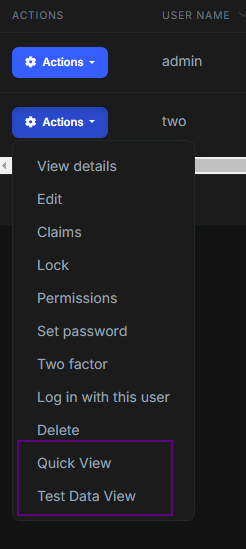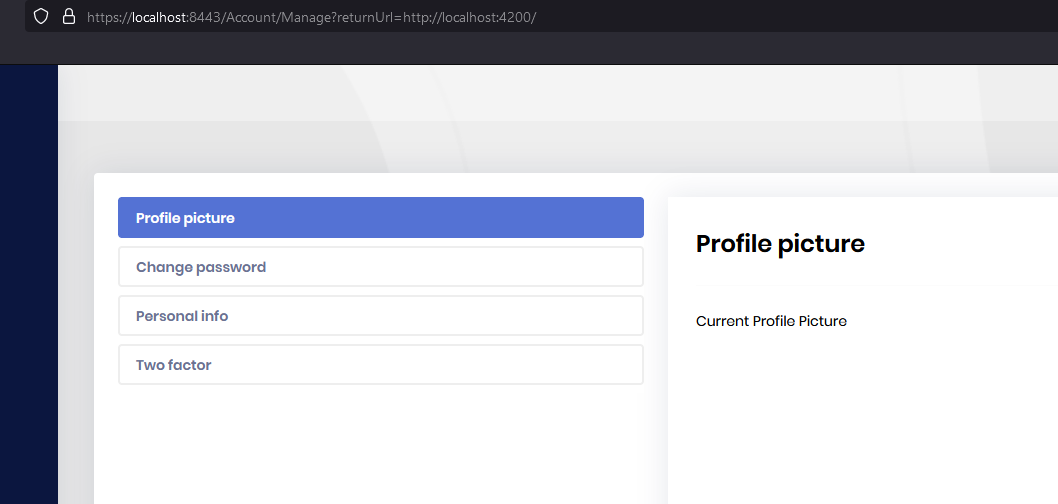Aktivity „sumeyye.kurtulus“
Hello, I suppose that your aim is to extend the entity actions for the identity module by giving two different routes. Here is how it is supposed to behave with the right config:
// src/app/identity-extended/entity-action-contributors.ts
import { EntityAction, EntityActionList } from '@abp/ng.components/extensible';
import { IdentityExtendedComponent } from './identity-extended.component';
import { IdentityUserDto } from '@volo/abp.ng.identity/proxy';
import { IdentityEntityActionContributors, eIdentityComponents } from '@volo/abp.ng.identity';
import { TestComponent } from './test/test.component';
const quickViewAction = new EntityAction<IdentityUserDto>({
text: 'Quick View',
action: data => {
const component = data.getInjected(IdentityExtendedComponent);
component.openUserQuickView(data.record);
},
});
const dataViewAction = new EntityAction<IdentityUserDto>({
text: 'Test Data View',
action: data => {
const component = data.getInjected(TestComponent);
component.openUserDataView(data.record);
},
});
export function customModalContributor(actionList: EntityActionList<IdentityUserDto>) {
actionList.addTail(quickViewAction);
actionList.addTail(dataViewAction);
}
export const identityEntityActionContributors: IdentityEntityActionContributors = {
// enum indicates the page to add contributors to
[eIdentityComponents.Users]: [
customModalContributor,
// You can add more contributors here
],
};
// src/app/identity-extended/identity-extended.module.ts
import { CoreModule } from '@abp/ng.core';
import { ThemeSharedModule } from '@abp/ng.theme.shared';
import { NgModule } from '@angular/core';
import { RouterModule } from '@angular/router';
import { identityEntityActionContributors } from './entity-action-contributors';
import { IdentityExtendedComponent } from './identity-extended.component';
import { IdentityModule } from '@volo/abp.ng.identity';
import { TestComponent } from './test/test.component';
@NgModule({
imports: [
CoreModule,
ThemeSharedModule,
RouterModule.forChild([
{
path: '',
component: IdentityExtendedComponent,
children: [
{
path: '',
loadChildren: () =>
IdentityModule.forLazy({
entityActionContributors: identityEntityActionContributors,
}),
},
],
},
{
path: 'test',
component: TestComponent,
children: [
{
path: '',
loadChildren: () =>
IdentityModule.forLazy({
entityActionContributors: identityEntityActionContributors,
}),
},
],
},
]),
],
declarations: [IdentityExtendedComponent],
})
export class IdentityExtendedModule {}
When the route is /identity/users , the Quick View button should work since then the referenced component. However, the Test Data View button will only work when you are redirected to /identity/test/users since then this button click is referenced to Test Component in the config.
If your case is different than this, we can assist you further on that.
I am delighted to hear that it worked! It is my pleasure to assist you.
Another detail that might help, when removing MANAGE_PROFILE_TAB_PROVIDER so I can get the site to load and open the MyAccount link, it goes to a page served directly from the HttpApi.Host (port 8443), not an Angular page (port 4200). I
Is that expected behaviour? Am I supposed to configure something in the host to let this work?
For the issue that you have mentioned where you are redirected to another port, you may need to check the version compatibility and you can follow these in that sense:
https://docs.abp.io/en/abp/5.3/UI/Angular/Account-Module#my-account-page https://docs.abp.io/en/commercial/5.3/modules/account#angular-ui
Besides you may also consider upgrading the version to 6.0 and use OpenIddict following https://docs.abp.io/en/commercial/6.0/migration-guides/openIddict-step-by-step
Here's password change module, unchanged from the ng generate version:
import { NgModule } from '@angular/core'; import { CommonModule } from '@angular/common'; import { PasswordChangeComponent } from './password-change.component'; @NgModule({ declarations: [ PasswordChangeComponent ], imports: [ CommonModule ] }) export class PasswordChangeModule { }Here's the component also unchanged:
import { Component, OnInit } from '@angular/core'; @Component({ selector: 'app-password-change', templateUrl: './password-change.component.html', styleUrls: ['./password-change.component.scss'] }) export class PasswordChangeComponent implements OnInit { constructor() { } ngOnInit(): void { } }Removing the reference to password change from app.module.ts leaves me with the same error:
NullInjectorError: R3InjectorError(AppModule)[ApplicationModule -> ApplicationRef -> ApplicationInitStatus -> InjectionToken Application Initializer -> [object Object] -> ManageProfileTabsService -> ManageProfileTabsService -> ManageProfileTabsService]: NullInjectorError: No provider for ManageProfileTabsService!Something else foundational is missing from the site implementation itself but I don't know where to look for it. What normally injects the ManageProfileTabsService into the stack? It isn't explicitly called in app.module.ts so what part of what file is doing it? I search the sites code base and only my manage-profile-tabs.provider.ts file references it, so the problem is in the framework somewhere. Did a later version of 5.3 get a bug fix to rectify this that I have to reproduce?
Setting that const MANAGE_PROFILE_TAB_PROVIDER is breaking some other validation or other.
Actually, there is no specific bug fix on this matter since then it was not reported before. I also could not reproduce the same problem.
Thank you for providing additional information. I will review this specific case and will respond to you at my earliest convenience.
Hello again, I have produced the case by creating a custom component named change-password and configured the tabs as follows:
for manage-profile-tabs.provider.ts
// angular\src\app\change-password\providers\manage-profile-tabs.provider.ts
import { APP_INITIALIZER } from '@angular/core';
import {
eAccountManageProfileTabNames,
ManageProfileTabsService,
} from '@volo/abp.ng.account/public/config';
import { ChangePasswordComponent } from '../change-password.component';
export const MANAGE_PROFILE_TAB_PROVIDER = {
provide: APP_INITIALIZER,
useFactory: configureManageProfileTabs,
deps: [ManageProfileTabsService],
multi: true,
};
export function configureManageProfileTabs(tabs: ManageProfileTabsService) {
return () => {
tabs.add([
{
name: '::ChangePassword',
order: 2,
component: ChangePasswordComponent,
},
]);
tabs.remove([eAccountManageProfileTabNames.ChangePassword]);
};
}
and then, added MANAGE_PROFILE_TAB_PROVIDER for the app module providers:
// angular\src\app\app.module.ts
import { CoreModule } from '@abp/ng.core';
import { GdprConfigModule } from '@volo/abp.ng.gdpr/config';
import { SettingManagementConfigModule } from '@abp/ng.setting-management/config';
import { ThemeSharedModule } from '@abp/ng.theme.shared';
import { NgModule } from '@angular/core';
import { BrowserModule } from '@angular/platform-browser';
import { BrowserAnimationsModule } from '@angular/platform-browser/animations';
import { CommercialUiConfigModule } from '@volo/abp.commercial.ng.ui/config';
import { AccountAdminConfigModule } from '@volo/abp.ng.account/admin/config';
import { AccountPublicConfigModule } from '@volo/abp.ng.account/public/config';
import { AuditLoggingConfigModule } from '@volo/abp.ng.audit-logging/config';
import { IdentityConfigModule } from '@volo/abp.ng.identity/config';
import { LanguageManagementConfigModule } from '@volo/abp.ng.language-management/config';
import { registerLocale } from '@volo/abp.ng.language-management/locale';
import { SaasConfigModule } from '@volo/abp.ng.saas/config';
import { TextTemplateManagementConfigModule } from '@volo/abp.ng.text-template-management/config';
import { environment } from '../environments/environment';
import { AppRoutingModule } from './app-routing.module';
import { AppComponent } from './app.component';
import { APP_ROUTE_PROVIDER } from './route.provider';
import { OpeniddictproConfigModule } from '@volo/abp.ng.openiddictpro/config';
import { FeatureManagementModule } from '@abp/ng.feature-management';
import { AbpOAuthModule } from '@abp/ng.oauth';
import { ThemeLeptonXModule } from '@volosoft/abp.ng.theme.lepton-x';
import { SideMenuLayoutModule } from '@volosoft/abp.ng.theme.lepton-x/layouts';
import { MANAGE_PROFILE_TAB_PROVIDER } from './change-password/providers/manage-profile-tabs.provider';
@NgModule({
declarations: [AppComponent],
imports: [
BrowserModule,
BrowserAnimationsModule,
AppRoutingModule,
CoreModule.forRoot({
environment,
registerLocaleFn: registerLocale(),
}),
AbpOAuthModule.forRoot(),
ThemeSharedModule.forRoot(),
AccountAdminConfigModule.forRoot(),
AccountPublicConfigModule.forRoot(),
IdentityConfigModule.forRoot(),
LanguageManagementConfigModule.forRoot(),
SaasConfigModule.forRoot(),
AuditLoggingConfigModule.forRoot(),
OpeniddictproConfigModule.forRoot(),
TextTemplateManagementConfigModule.forRoot(),
SettingManagementConfigModule.forRoot(),
CommercialUiConfigModule.forRoot(),
FeatureManagementModule.forRoot(),
GdprConfigModule.forRoot({
privacyPolicyUrl: 'gdpr-cookie-consent/privacy',
cookiePolicyUrl: 'gdpr-cookie-consent/cookie',
}),
ThemeLeptonXModule.forRoot(),
SideMenuLayoutModule.forRoot(),
],
providers: [APP_ROUTE_PROVIDER, MANAGE_PROFILE_TAB_PROVIDER], //added MANAGE_PROFILE_TAB_PROVIDER here
bootstrap: [AppComponent],
})
export class AppModule {}
Normally, this should be enough to get the expected behavior. However, I suspect that something that has been configured in PasswordChangeModule may cause the injection error. That would be the best if you can provide a little more detail on this. Thank you for your cooperation.
Hello @lukas.augustin. Considering your case, there is no need to add extra configurations for the frontend side to extend the form properties. Extending the related object by using module entity extensions system would be enough.
Hello, once again. Thank you for the explanation. Currently, the users cannot generate a CRUD entity structure that has a date-time range property directly.
If your aim is to manage such structure, you will need to implement your own custom logic that may be held in the form of start date-time and end date-time values in the backend side. In the meantime, you can implement the frontend behavior accordingly.
You can also specifically address how you want this implementation behave, so that we can help further.
Hello, I assume that your aim is to use date range picker component for advanced filters in a CRUD page. If this is the case, you can directly use <abp-date-range-picker></abp-date-range-picker> component. Here is an example:
<abp-date-range-picker
startDateProp="dateOneMin"
endDateProp="dateOneMax"
[(ngModel)]="service.filters"
[ngModelOptions]="{ standalone: true }"
>
</abp-date-range-picker>
If it does not match with your case, we are open to any follow-up questions.


